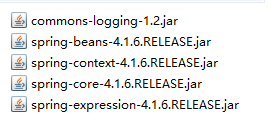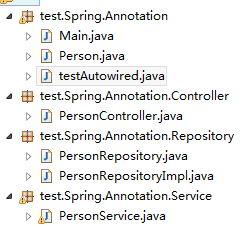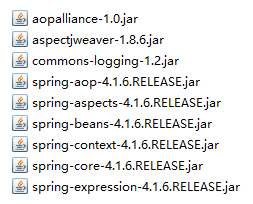Spring学习总结
来源:互联网 发布:淘宝上买dota2饰品条件 编辑:程序博客网 时间:2024/06/03 23:42
一、导入Spring必须的jar包

二、简单示例入门注入一个User
1.编写User实体类
package test.Spring.helloworld;import java.util.List;import java.util.Map;public class User { @Override public String toString() { return "User [id=" + id + ", name=" + name + "]"; } public int getId() { return id; } public void setId(int id) { this.id = id; } public String getName() { return name; } public void setName(String name) { this.name = name; } private int id; private String name; }
2.编写Spring配置文件,类型为xml,文件名可以自定义
<?xml version="1.0" encoding="UTF-8"?><beans xmlns="http://www.springframework.org/schema/beans" xmlns:xsi="http://www.w3.org/2001/XMLSchema-instance" xsi:schemaLocation="http://www.springframework.org/schema/beans http://www.springframework.org/schema/beans/spring-beans.xsd" > <bean id="User" class="test.Spring.helloworld.User"> <property name="id" value="1"></property> <property name="name" value="jayjay"></property> </bean></beans>
3.利用Spring容器创建托管对象User
ApplicationContext context =new ClassPathXmlApplicationContext("applicationContext.xml"); User u = (User)context.getBean("User"); System.out.println(u);
三、Bean的配置深入
1.bean引用其他bean
实体类示例:
package test.Spring.helloworld;public class HelloWorld { public User getUser() { return user; } public void setUser(User user) { this.user = user; } @Override public String toString() { return "HelloWorld [name=" + name + ", user=" + user + "]"; } public String getName() { return name; } public void setName(String name) { this.name = name; } private String name; private User user; public HelloWorld(){ } public HelloWorld(String name){ this.name = name; }}
配置示例:
<!-- reference other bean --> <bean id="HelloWorld" class="test.Spring.helloworld.HelloWorld"> <!-- <property name="name" value="spring1"></property> --> <constructor-arg value="spring2" type="java.lang.String"></constructor-arg> <property name="user"> <ref bean="User"/> </property> </bean>
调用方法依然是根据bean中的id
2.集合bean配置
实体类示例:
package test.Spring.helloworld;import java.util.List;import java.util.Map;public class User { public Map<String, Integer> getMap() { return map; } public void setMap(Map<String, Integer> map) { this.map = map; } public List<String> getList() { return list; } public void setList(List<String> list) { this.list = list; } @Override public String toString() { return "User [id=" + id + ", name=" + name + ", list=" + list + ", map=" + map + "]"; } public int getId() { return id; } public void setId(int id) { this.id = id; } public String getName() { return name; } public void setName(String name) { this.name = name; } private int id; private String name; private List<String> list; private Map<String,Integer> map; }
配置示例:
<!-- Configure the list bean --> <bean id="testList" class="test.Spring.helloworld.User"> <property name="list"> <list> <value>list1</value> <value>list2</value> <value>list3</value> </list> </property> </bean> <!-- configure the map --> <bean id="testMap" class="test.Spring.helloworld.User"> <property name="map"> <map> <entry key="first" value="1"></entry> <entry key="second" value="2"></entry> <entry key="third" value="3"></entry> </map> </property> </bean>
3.Properties类型的bean
实体类示例:
package test.Spring.helloworld;import java.util.Properties;public class DataSource { @Override public String toString() { return "Properties [properties=" + properties + "]"; } public Properties getProperties() { return properties; } public void setProperties(Properties properties) { this.properties = properties; } private Properties properties; }
配置示例:
<!-- configure the properties --> <bean id="dataSource1" class="test.Spring.helloworld.DataSource"> <property name="properties"> <props> <prop key="user">root</prop> <prop key="password">1234</prop> <prop key="jdbcUrl">jdbc:mysql:///test</prop> <prop key="driverClass">com.mysql.jdbc.Driver</prop> </props> </property> </bean>
4.使用Util定义引用其他bean的公共集合
需要先在xml导入命名空间
<?xml version="1.0" encoding="UTF-8"?><beans xmlns="http://www.springframework.org/schema/beans" xmlns:xsi="http://www.w3.org/2001/XMLSchema-instance" xsi:schemaLocation="http://www.springframework.org/schema/beans http://www.springframework.org/schema/beans/spring-beans.xsd http://www.springframework.org/schema/util http://www.springframework.org/schema/util/spring-util-4.0.xsd" xmlns:util="http://www.springframework.org/schema/util" > </beans>
集合以及调用的xml配置
<!-- if properties of collection are beans --> <util:list id="users"> <ref bean="User"/> <ref bean="User"/> <ref bean="User"/> </util:list> <bean id="Users" class="test.Spring.helloworld.Users"> <property name="list"> <ref bean="users"/> </property> </bean>
5.使用p简化bean的属性赋值
首先,导入p的命名空间
xmlns:p="http://www.springframework.org/schema/p"
实体类实例:
package test.Spring.helloworld;import java.util.List;import java.util.Map;public class User { @Override public String toString() { return "User [id=" + id + ", name=" + name + "]"; } public int getId() { return id; } public void setId(int id) { this.id = id; } public String getName() { return name; } public void setName(String name) { this.name = name; } private int id; private String name; }
配置示例:
<!-- use p to write the bean quickly and conveniently --> <bean id="User1" class="test.Spring.helloworld.User" p:id="2" p:name="jayjay2" />
6.abstract模板bean
设置abstract=true表明此bean是模板bean,为其他bean提供属性值模板
<!-- template bean --> <bean abstract="true" id="template" p:id="50" p:name="fromTemplate"></bean> <bean id="User2" parent="template" class="test.Spring.helloworld.User"></bean>
7.单例bean和原型bean
<!-- use scope to build singleton/prototype bean --> <bean id="User3" parent="template" scope="singleton" class="test.Spring.helloworld.User"></bean> <bean id="User4" parent="template" scope="prototype" class="test.Spring.helloworld.User"></bean>
singleton:此bean为单例,在context创建时已经创建,并且只有一个实例。
prototype:当需要时创建实例。
8.静态工厂方法配置bean
静态工厂类示例:
package test.Spring.FactoryBean;import java.util.HashMap;import java.util.Map;public class StaticFactoryMethod { public static Map<String,Person> map = new HashMap<String,Person>(); static { map.put("first", new Person(1,"jayjay1")); map.put("second", new Person(2,"jayjay2")); } public static Person getPerson(String key){ return map.get(key); }}
配置示例:
<!-- static factory method --> <bean id="person" factory-method="getPerson" class="test.Spring.FactoryBean.StaticFactoryMethod"> <constructor-arg value="first" type="java.lang.String"></constructor-arg> </bean>
9.实例工厂方法配置bean
工厂类示例:
package test.Spring.FactoryBean;import java.util.HashMap;import java.util.Map;public class InstanceFactoryMethod { public static Map<String,Person> map = new HashMap<String,Person>(); static { map.put("first", new Person(1,"jayjay1")); map.put("second", new Person(2,"jayjay2")); } public Person getPerson(String key){ return map.get(key); }}
配置示例:
<!-- instance factory method --> <bean id="InstanceFactoryMethod" class="test.Spring.FactoryBean.InstanceFactoryMethod"></bean> <bean id="person1" factory-bean="InstanceFactoryMethod" factory-method="getPerson"> <constructor-arg value="second"></constructor-arg> </bean>
10.通过实现FactoryBean完成bean的配置
需要对FactoryBean接口的3个方法进行适当重写
PersonFactoryBean类示例:
package test.Spring.FactoryBean;import org.springframework.beans.factory.FactoryBean;public class PersonFactoryBean implements FactoryBean<Person>{ public int getId() { return id; } public void setId(int id) { this.id = id; } public String getName() { return name; } public void setName(String name) { this.name = name; } private int id; private String name; @Override public Person getObject() throws Exception { // TODO Auto-generated method stub return new Person(id,name); } @Override public Class<?> getObjectType() { // TODO Auto-generated method stub return Person.class; } @Override public boolean isSingleton() { // TODO Auto-generated method stub return false; }}
配置示例:
<!-- use factory bean to get a instance --> <bean id="person2" class="test.Spring.FactoryBean.PersonFactoryBean"> <property name="id" value="3"></property> <property name="name" value="FactoryBean"></property> </bean>
四、通过注解配置bean
加上注解的类会被Spring容器管理
@Component
标注于通用实体类
@Controller
标注于Controller/Action
@Service
标注于Service
@Respository
标注于RespositoryImpl/DaoImlp
@Autowired
依据类型自动装配
@Qualifier
指定自动装载的bean的name
1.在Spring配置文件中导入context命名空间,并加入
<context:component-scan base-package="test.Spring.Annotation"></context:component-scan>
表示Spring将扫描test.Spring.Annotation及其子包中所有java文件,并将带有注解的类加入Spring容器进行管理。
例如:
<?xml version="1.0" encoding="UTF-8"?><beans xmlns="http://www.springframework.org/schema/beans" xmlns:xsi="http://www.w3.org/2001/XMLSchema-instance" xsi:schemaLocation="http://www.springframework.org/schema/beans http://www.springframework.org/schema/beans/spring-beans.xsd http://www.springframework.org/schema/context http://www.springframework.org/schema/context/spring-context.xsd" xmlns:context="http://www.springframework.org/schema/context"> <context:component-scan base-package="test.Spring.Annotation"></context:component-scan></beans>
2.模拟三层,并用Spring注解方式注入
项目结构:

Person实体类
package test.Spring.Annotation;import org.springframework.stereotype.Component;@Componentpublic class Person { @Override public String toString() { return "Person [id=" + id + ", name=" + name + "]"; } public int getId() { return id; } public void setId(int id) { this.id = id; } public String getName() { return name; } public void setName(String name) { this.name = name; } private int id; private String name;}
PersonController
package test.Spring.Annotation.Controller;import org.springframework.stereotype.Controller;@Controllerpublic class PersonController { public void excute(){ System.out.println("PersonController.excute()..."); }}
PersonService
package test.Spring.Annotation.Service;import org.springframework.stereotype.Service;@Servicepublic class PersonService { public void add(){ System.out.println("PersonService.add()..."); }}
PersonRepository接口
package test.Spring.Annotation.Repository;public interface PersonRepository { void add();}
PersonRepositoryImpl接口实现类
package test.Spring.Annotation.Repository;import org.springframework.stereotype.Repository;@Repositorypublic class PersonRepositoryImpl implements PersonRepository { @Override public void add() { System.out.println("PersonRepositoryImpl.add()..."); }}
Main类中测试
package test.Spring.Annotation;import org.springframework.context.ApplicationContext;import org.springframework.context.support.ClassPathXmlApplicationContext;import test.Spring.Annotation.Controller.PersonController;import test.Spring.Annotation.Repository.PersonRepository;import test.Spring.Annotation.Service.PersonService;public class Main { public static void main(String[] args) { ApplicationContext context =new ClassPathXmlApplicationContext("applicationContextForAnnotation.xml"); //inject the common bean System.out.println(context.getBean("testAutowired")); //inject the repository PersonRepository pr = (PersonRepository)context.getBean("personRepositoryImpl"); pr.add(); //inject the controller PersonController pc = (PersonController)context.getBean("personController"); pc.excute(); //inject the service PersonService ps = (PersonService)context.getBean("personService"); ps.add(); }}
3.泛型三层的注入
Spring配置文件
<?xml version="1.0" encoding="UTF-8"?><beans xmlns="http://www.springframework.org/schema/beans" xmlns:xsi="http://www.w3.org/2001/XMLSchema-instance" xsi:schemaLocation="http://www.springframework.org/schema/beans http://www.springframework.org/schema/beans/spring-beans.xsd http://www.springframework.org/schema/context http://www.springframework.org/schema/context/spring-context.xsd " xmlns:context="http://www.springframework.org/schema/context" > <context:component-scan base-package="test.Spring.Generic.di"></context:component-scan></beans>
BaseRespository
package test.Spring.Generic.di;public class BaseRepository<T> { public void save() { System.out.println("repository.save()..."); }}
PersonRepository
package test.Spring.Generic.di;public interface PersonRespository { void save();}
PersonRepositoryImpl
继承BaseRepository就不需要再写一次save方法,且同时实现了PersonRepository接口
package test.Spring.Generic.di;import org.springframework.stereotype.Repository;import test.Spring.Annotation.Person;@Repositorypublic class PersonRespositoryImpl extends BaseRepository<Person> implements PersonRespository {}
BaseService对Dao进行自动装配,子类继承后装配的是子类Respository
package test.Spring.Generic.di;import org.springframework.beans.factory.annotation.Autowired;public class BaseService<T> { @Autowired protected BaseRepository<T> baseRespository; public void save(){ System.out.println("service.save()..."); System.out.println(baseRespository); }}
PersonService继承了BaseService,就不需要再写实现save方法,定义Repository字段了
package test.Spring.Generic.di;import org.springframework.stereotype.Service;import test.Spring.Annotation.Person;@Servicepublic class PersonService extends BaseService<Person>{ }
Main类中调用
package test.Spring.Generic.di;import org.springframework.context.ApplicationContext;import org.springframework.context.support.ClassPathXmlApplicationContext;public class Main { public static void main(String[] args) { ApplicationContext context =new ClassPathXmlApplicationContext("applicationContextForGeneric.xml"); PersonService ps = (PersonService)context.getBean("personService"); ps.save(); }}
输出为

第二句说明调用的是继承BaseService的PersonService拿到的Respository是PersonRepositoryImpl,说明泛型注入成功。
五、使用SpringAOP完成简单的程序
1.导入SpringAOP所需jar包

2.编写spring的配置文件applicationContext.xml
<?xml version="1.0" encoding="UTF-8"?><beans xmlns="http://www.springframework.org/schema/beans" xmlns:xsi="http://www.w3.org/2001/XMLSchema-instance" xsi:schemaLocation="http://www.springframework.org/schema/beans http://www.springframework.org/schema/beans/spring-beans.xsd http://www.springframework.org/schema/util http://www.springframework.org/schema/util/spring-util-4.0.xsd http://www.springframework.org/schema/context http://www.springframework.org/schema/context/spring-context.xsd http://www.springframework.org/schema/aop http://www.springframework.org/schema/aop/spring-aop.xsd " xmlns:util="http://www.springframework.org/schema/util" xmlns:p="http://www.springframework.org/schema/p" xmlns:context="http://www.springframework.org/schema/context" xmlns:aop="http://www.springframework.org/schema/aop" > <!-- configure the package for spring to scan --> <context:component-scan base-package="test.Spring.AOP" /> <!-- make the aspectj annotation to be used --> <aop:aspectj-autoproxy></aop:aspectj-autoproxy></beans>
3.创建一个HelloWord接口以及它的实现类HelloWordImpl
public interface HelloWord { public int sayHello(int num);}
@Componentpublic class HelloWordImpl implements HelloWord{ public int sayHello(int num){ System.out.println("hello word"); return 100/num; }}
4.SpringAOP注释的类型有5种
@Before 前置通知 在方法执行前执行
@After 后置通知 在方法执行后执行
@AfterThrowing 异常通知 在方法抛出异常之后执行
@AfterReturning 返回通知 在方法返回结果之后执行
@Around 环绕通知 环绕着方法执行
5.创建一个切面类(包含@Before @After @AfterThrowing @AfterReturning)
@Component@Aspectpublic class HelloWordAspect { @Before(value="execution(* test.Spring.AOP.HelloWord.sayHello(..))") public void beforeMethod(JoinPoint jp){ String methodName = jp.getSignature().getName(); System.out.println(methodName); System.out.println("before method execute,args are "+Arrays.toString(jp.getArgs())); } @After("execution(* test.Spring.AOP.HelloWord.sayHello(..))") public void afterMethod(JoinPoint jp){ System.out.println("after method execute,args are "+Arrays.toString(jp.getArgs())); } @AfterThrowing(value="execution(* test.Spring.AOP.HelloWord.sayHello(..))",throwing="ex") public void afterThrow(Exception ex){ System.out.println("afterThrow"+ex.getMessage()); } @AfterReturning(value="execution(* test.Spring.AOP.HelloWord.sayHello(..))",returning="result") public void afterReturn(Object result){ System.out.println("the result is "+result); }}
6.在主函数调用
public class Main { public static void main(String[] args) { ApplicationContext context = new ClassPathXmlApplicationContext("applicationContextForAOP.xml"); HelloWord hw = (HelloWord) context.getBean("helloWordImpl"); hw.sayHello(10); }}
7.调用结果

结果说明,在sayHello方法是被Spring代理执行了,执行前后加上了一些切面类中定义的信息。
8.使用Around环绕通知切面类实现类似效果
@Component@Aspectpublic class HelloWordAspectAround { @Around(value="execution(* test.Spring.AOP.HelloWord.sayHello(..)))") public Object aroundMethod(ProceedingJoinPoint pjp){ Object result = null; String methodName = pjp.getSignature().getName(); try { result = pjp.proceed(); System.out.println("the result is "+result); } catch (Throwable e) { System.out.println("Exception occurs : "+e.getMessage()); throw new RuntimeException(e); } System.out.println(methodName+" end"); return result; }}
- Spring核心技术学习总结
- 宝宝spring学习总结
- spring AOP学习总结
- Spring Security学习总结
- spring学习总结
- Spring学习总结
- Spring学习总结
- Spring integration学习总结
- spring学习总结
- 宝宝spring学习总结
- Spring AOP 学习总结
- Spring学习总结
- Spring+SpringSecurity 学习总结
- Spring @ModelAttribute学习总结
- Spring Security学习总结
- Spring核心技术学习总结
- Spring FrameWork 学习总结
- Spring Security学习总结
- jquery绑定事件
- 用java编写的“私人备忘录”
- Banner的简单使用
- 递归方式实现打印一个整数的每一位
- Python List 列表
- Spring学习总结
- ubuntu无法打开terminal
- 欢迎使用CSDN-markdown编辑器
- OpenCV 2.4.9在Ubuntu下的配置与安装
- AngluarJS增删
- Java EE JSP编程基础
- LeetCode-029 Divide Two Integers
- Banner轮播
- webview的基本使用



